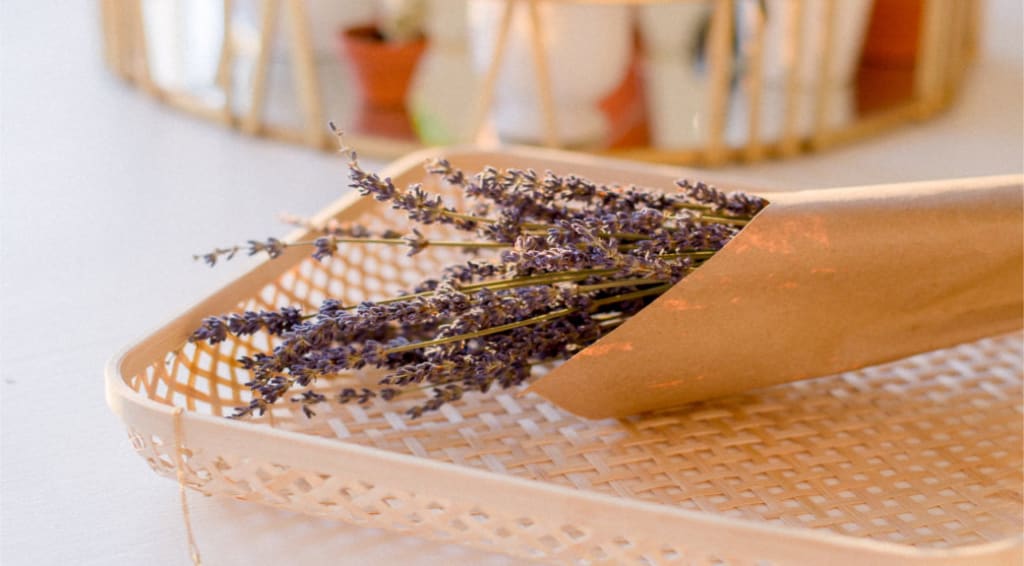The Best Ways to Use Lavender
Perfume Your Life With Lavender

An herb of many names, lavender’s most common name is garden lavender. The uses for lavender are as versatile as its names. Lavender’s use since ancient times and benefits as a timeless herb make it a household name. Utilized for food, healing and relaxation, lavender is one of the most well rounded herbs. And I’m here to tell you why. Oh yeah, you can skip the technical stuff and scroll to the bottom for the list of best ways to use lavender. You can also see me talk about the benefits and uses of lavender in my own products!
The Basics About Lavender
Lavender is part of the Labiatae family. The Labiate family is also known as Lamiaceae family or mint family. It includes many smell-good mints and balms. Some of note are basil, catnip, lemon balm, peppermint, oregano, rosemary, chia, sage and thyme. Lavender is a perennial (grows back each year) shrub that grows up to three feet tall. The plant has spikes of violet-blue flowers extending from the base foliage. As with most blue and purplish plants, lavender has cooling and nervine properties.
Lavender became popular as a medicine during the late Middle Ages. Since then, lavender has come close to being considered a cure for almost everything. A fun fact is that “lavender” means “to wash” in Latin. Think of all the languages where you see the root “lav” used. For example, “lavar” is “to wash” in Spanish. Pretty neat, huh? Maybe that is one reason why lavender is used for so many bath and cleaning products.
The Part of Lavender That Is Used
There is only one part of the lavender plant that is used: the flowering tops. The flowers can be used fresh or dried. It is from the flowers that we get the ever so potent essential oil. Lavender oil has a low toxicity level and great antiseptic and antibacterial properties. The flowers also boast antiseptic and antibacterial properties.

The Name of Lavender Changes the Game
The Latin name of an herb is important for knowing the best use. This is because the Latin name lets you know the specific properties of that species. For example, the most popular species of lavender for commercial use are Lavendula angustifolia and Lavendula officinalis. Spike lavender (L. spica) produces a lot more essential oil, so it is preferred in the perfume and commercial world. Spike lavender is also higher in camphor and cineole. These biochemical compounds make spike lavender great in insect and moth repellents. Lavendula angustifolia is a Bulgarian variety. It is extremely popular as an essential oil and herb since it is considered safe for children and the elderly. But Lavendula officinalis is preferred for essential oil, because it produces superior oil.
Properties and Benefits of Lavender
From an herbal perspective, lavender’s energy and flavor is considered spicy, fragrant, mildly bitter and cool. Lavender’s benefits include calming, regenerative, healing, sedative, astringent, antihistamine, cytophylactic, and antispasmodic. Ultimately, lavender is most known for its relaxing and healing properties. I love working with lavender because it is an antidepressant, analgesic (pain reliever), hypotensive nervine, relaxing, soothing, antibacterial and cardiotonic. Lavender is also antiviral, antifungal, antiseptic, carminative—herbs that help relieve gas and griping (sever pain in the bowels)—, antioxidant, and stimulates blood flow.
Lavender’s calming property makes it an excellent aid for sleep issues, insomnia, nightmares, depression, stress, anxiety, focus and concentration, migraines, headaches, mood swings, nervous tension and emotional balance. Lavender is good for allergies, hay fever, asthma, bronchial problems, flu symptoms, lice and insect repellents. In terms of pain, lavender can help relieve symptoms of sunburns, burns, pains, strains, sprains, cuts, wounds, blisters and bee and wasp stings. Lavender also helps calm issues associated with scars, inflammation, boils, rashes, psoriasis, abscesses, acne, eczema, dermatitis and alopecia. Other conditions lavender might help with are teeth grinding, high blood pressure, menstrual regulation, vertigo, ear ache indigestion and colic.
The Aromatherapy of Lavender
Nowadays essential oils and diffuser are much more common. Stroll through your local CVS and you can pick up a whole set of essential oils with a diffuser. But just because you are using essential oils does not mean you are truly practicing aromatherapy. There are guidelines to how many drops or percentage of an oil need to be used in order to be considered legitimate aromatherapy. Aromatherapy is the use of an herb’s smell to help reduce or eliminate symptoms from ailments.
If you are not into buying essential oils quite yet, there are some simple options. The first is to grow a lavender plant in your garden or buy a potted plant. Lavender is highly aromatic, so you only need to be near it to catch a whiff of pure bliss. The second is to run your fingers or hand over the flowers. This will release some essential oils and perfume whatever it touches. Just try not to look crazy sniffing your hand all day for no apparent reason.

Different Ways To Use Lavender Every Day
Grow lavender in your garden or in a potted plant. Then run your fingers through it!
Buy lavender flowers and place small bouquets throughout your home. Breath in the goodness.
Use the essential oil in a diffuser or for applications like raindrop therapy.
Use the essential oil for topical problems like stings, cuts, bruises and burns.
Add lavender flowers to your food to spice things up.
Add lavender essential oil to drinks and baked goods.
Make lavender tea and let your stress melt away.
Use lavender for herbal medicine.
Make your own lavender herbal infusions like vinegar, honey, tincture and oil.
Purchase lavender based cleaning products (the real stuff, not lavender fragrance).
Whip up your own handmade soap, cream, mist or solid perfume.
Precautions For Using Lavender
Lavender is deemed a relatively safe herb to use. You can sprinkle the dried flowers in your desserts or use as garnish for a salad. However, you should only ingest lavender essential oil under professional supervision. Even though lavender essential oil is considered safe to be applied neat (applied directly to skin without a carrier oil), be sure not to overuse. Typically, only two to three drops of oil are sufficient for most applications. According to some, L. officinalis is not considered widely safe for use with children or the elderly.
Why I Love Lavender
While lavender may seem overly used or advertised, there are many benefits that keep lavender number one in many books. I love using lavender because I have had great success with its applications personally and professionally. Although some people might have an aversion to the smell of lavender, it often serves as a diagnostic tool for me. Sometimes what are bodies try to avoid is what our soul is actually calling for. For example, for clients that can’t stand the smell of lavender, they might have an underlying issue of not being able to relax or are constantly stressed.
Please consult your primary physician before using herbal remedies. The information above is for self-educative purposes only, and should not be used in place of professional medical advice.
About The Author
Stephanie works as an herbalist, naturopath and energy healer. She is creator and maker of the handmade, all natural, customizable Bradberry® brand of herbal products. Stephanie helps her clients find natural solutions for their unique health, wellness and skincare needs.
To learn more, please visit stephaniebradberry.com
About the Creator
Stephanie J. Bradberry
I have a passion for literature and anime. And I love everything involving academia, health, metaphysics and entrepreneurship.
For products and services, visit: stephaniebradberry.com
For online courses, visit: bradberryacademy.com
Reader insights
Nice work
Very well written. Keep up the good work!
Top insight
Expert insights and opinions
Arguments were carefully researched and presented






Comments (1)
Thank you for this informative article :)